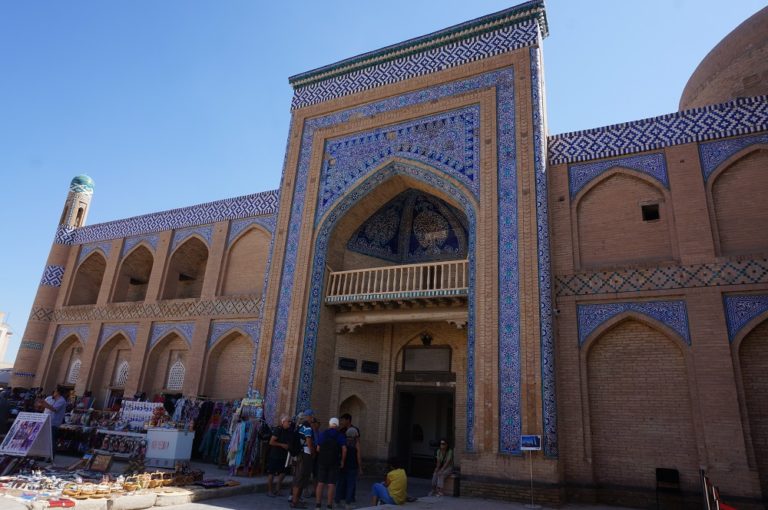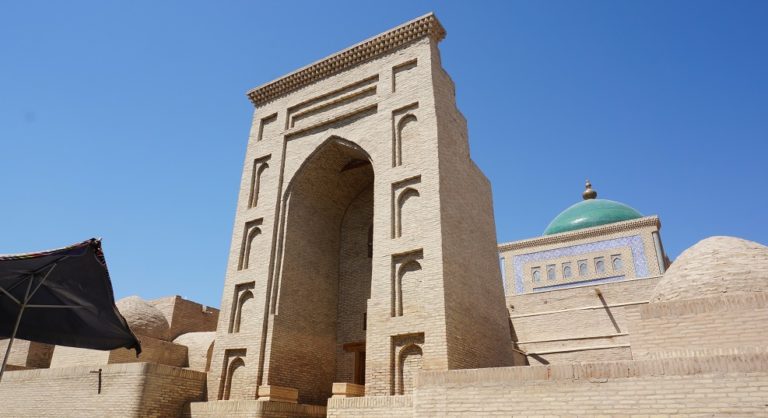A City where You Can Experience the Feeling of Time Traveling to the Middle Ages – Khiva
Khiva, a World Heritage city located in the western Horazm region of Uzbekistan.
It is said to have developed as a gateway to the Karakum Desert since ancient times.
In 1592, it became the capital of the Khanate of Khiva, and in 1842, the town was divided into Itchan-Kala (Inner City) and Dishan-Kala (Outer City). The Itchan-Kala, now designated as a tourist destination, was the area for the palace of the Khanate of Khiva, where high-ranking officials, wealthy merchants, and clergy lived. People still reside in the area between the inner and outer walls.
Most of the remaining buildings date back to the 17th century or later.
In 1969, Itchan-Kala was designated as a museum city, and in 1990, it became the first site in Uzbekistan to be listed as a UNESCO World Heritage site.
Within the small Itchan-Kala, you can explore 20 mosques, 20 madrasahs, and 6 minarets.
Taking a leisurely day to visit these sites is a delightful experience. The unique Khorezm culture, distinct even within Uzbekistan, can be felt through its cuisine, dance, and more.
Attractions in Khiva
Kuhna Ark
Kuhna Ark, meaning “Old Palace,” is located adjacent to the western gate of Itchan Kala in Khiva.
Built in the 17th century, the palace housed administrative rooms, an audience chamber, a mosque, and a harem. Additionally, it contained facilities like a gunpowder factory, a mint, and an arsenal.
It is famous for producing silk banknotes during that time.
The intricate tilework, particularly Ivan’s tiles, is remarkable. The walls are adorned with faience tiles, while the ceilings feature colorful patterns in red, yellow, green, and black.
Visitors can climb a part of the city walls from within Kuhna Ark, offering magnificent views of Itchan Kala towards the east, making it an ideal spot for enjoying the sunset.

Kalta Minor Minaret
Upon entering from the western gate, you’ll immediately notice the short and blue minaret, “Kalta Minor.”
“Kalta” means “short.” In 1852, construction began to build the tallest minaret in Central Asia by Muhammad Amin Khan, but it was interrupted, leaving only the foundation, which is 26 meters high with a diameter of 14 meters. The construction was halted due to the death of Muhammad Amin Khan during his Persian campaign.
There’s a legend behind the interruption: “It is said that he wanted to build a tall tower to watch over Bukhara, but the Bukhara king found out and tried to stop the work by bribing the workers. Angry, Amin Khan killed the workers.”
At night, it is illuminated.

Muhammad Amin-Khan Madrasah
Entering through the western gate of Itchan Kala in Khiva, just to the right of Kalta Minor, you’ll find the Muhammad Amin-Khan Madrasah.
Built in 1852 by order of Muhammad Amin Khan, this madrasah was said to accommodate 99 students at the time.
It spans 71.7 meters by 60 meters, with a courtyard measuring 38 meters by 38 meters. The two-story building houses a total of 125 rooms.
During the Soviet era, it ceased to function as a theological school, but it is now utilized as a hotel. It’s incredibly popular as a hotel within the historical site.

Tash Khovli Palace
Tash Khovli Palace, located near the eastern gate of Itchan Kala, was constructed between 1830 and 1838.
“Tash” means stone and “Khovli” means palace. This palace, built by Allakuli Khan, is adorned with the most lavish tiles and pillars in Khiva. It is also referred to as the “New Palace.”
Divided into audience chambers, ceremonial spaces, banquet halls, and a harem, it features a labyrinthine layout allowing visitors to navigate through various rooms.
The two-story harem is adorned with 163 rooms of varying sizes, embellished with blue geometric patterned tiles.
The larger rooms on the southern side were designated for the Khan’s administrative purposes and for his four primary wives; there are tales that Allakuli Khan had four primary wives and forty concubines.

Juma Mosque
The Juma Mosque, said to have been the largest mosque in Central Asia around the 10th century, has its current form reconstructed and built in the 18th century.
Stepping inside the mosque, one is greeted by the dimly lit interior supported by 213 wooden pillars, each intricately carved, imbuing the mosque with a sense of history.
With dimensions measuring 55×46 meters and a height of 5 meters, the pillars stand at intervals of 3.15 meters, a spacing and number calculated to ensure that the face of every worshipper can be seen by the preacher (Imam).
Among these pillars, four date back to the 10th-11th centuries, while twenty-five others are from the 17th century.
Inside, one might find women knitting socks by hand, adding to the relaxed atmosphere of the space.
The interplay of light filtering through the ceiling further enhances the mosque’s beauty.

Islam Khodja Madrassah/Minaret
The Islam Khodja Complex, the tallest minaret in Khiva at 45 meters and the newest madrassah.
It was built in 1910 by Islam Khodja, the minister of Isfandiyar Khan, the last khan of Khiva.
Islam Khodja reportedly visited Russia to develop the country, establishing European-style schools, hospitals, and post offices. However, he became very popular, which led to a conspiracy by the khan and clergy, resulting in his being buried alive.
While the minaret is impressive, the madrassah is not very large, consisting of only 42 small rooms.
Unlike other madrassahs, it does not have a central courtyard.
Visitors can climb up the minaret’s 118 steps to overlook the city of Khiva, making it a recommended spot.


Pahlavan Mahmoud Mausoleum
The distinctive building with a large blue dome, the Pahlavan Mahmud Mausoleum.
“Pahlavan” means “hero” or “strongman.”
This mausoleum is dedicated to Pahlavan Mahmud, who was once revered as a patron.
He was famous for being a furrier, poet, philosopher, and a master of Kurash, a traditional Uzbek martial art, hence the name “Pahlavan” or strongman.
The most luxurious mausoleum belongs to Pahlavan Mahmud, and the prominent tombstone at the front is for Muhammad Rahim Khan. Additionally, relatives of khans from the 14th to the 20th century are also interred here.
It is believed that being buried near a saint ensures happiness in the afterlife, which led to the creation of many tombs around his grave.
Inside, it is cool and refreshing, with beautifully tiled walls covering every surface.

Allakuli Khan Madrassah
The Allakuli Khan Madrassah, constructed between 1830 and 1840, is located to the east of Itchan Kala in Khiva.During the time of Allakuli Khan, a caravanserai and bazaar were built.
The entrance to the madrassah has been converted into a restaurant. Additionally, the adjacent building, which used to be a caravanserai, now houses souvenir shops where you can purchase Uzbekistan goods such as socks and Suzani embroidery, specialties of Khiva.

